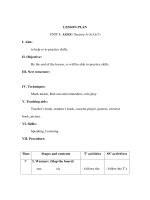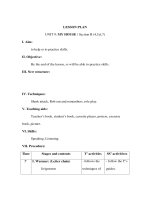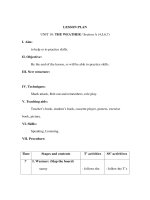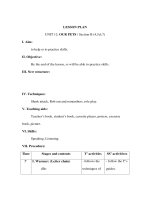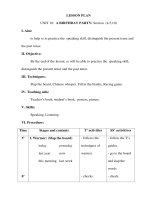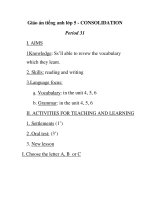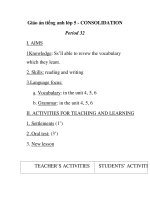Giáo án tiếng anh lớp 5 file word
Bạn đang xem bản rút gọn của tài liệu. Xem và tải ngay bản đầy đủ của tài liệu tại đây (271.74 KB, 17 trang )
WEEK 1
Date of preparing; 4/9/2016.
Date of teaching; 6/9/2016. 5B,5A
PERIOD 1. UNIT 1: WHAT’S YOUR ADDRESS?
LESSON 1. 1,2,3
I. Objectives
1. Knowledge
By the end of the lesson students will be able to;
- Use the words and phrases related to the topics Addresses and hometown.
- Asking and answering questions about someone’s address using What’s your
address?. It’s ...
2. Skills
- Develop Ss all four skills
3. Language focus:
- Sentence Patterns: What’s your address?. It’s ...
- Vocabulary: address,
II. Teaching aids:
1. Teacher’s: student’s and teacher’s book, pictures, cassette.
2. Students’: books, notebooks, workbooks.
III. Teaching processes:
Time
Teacher’s activities
Students’ activities
5’
I. Warm up.
- Have the class play Slap the board, using
- Play game Slap the board.
the pictures and names of the characters that
they have learnt in Tieng Anh 3 and Tieng
Anh 4, like Mai, Nam, Quan, Phong, Linda,
Tony, Tom, hakim and Akiko. When the game
is over, get them to point at each picture and
say sentences. For example, This is Mai.
She’s from Viet Nam. She’s Vietnamese. At
the end of the game, introduce Unit 1 by
writing the title on the board and have pupils
repeat it aloud.
12’
II. New lesson.
1. Look, Listen and repeat.
- Teach some newwords.
- Newcomer:
- Lane:
- Floor:
- Tower
- Have the class look at the pictures. - Copy down in notebook.
- Read individual and choral
Introduce the story by pointing at
each character and elicit their
answers to the questions:
+Who’s this?
- Look at the pictures and answers
+ What’s his/her name?
+Is he/she a newcomer?
to the questions.
+ Where’ he/she from?
+Where’s he/she living now?
(In Picture a, Nam is greeting Mai and
introducing her to Trung, a new pupil in their
class. In Picture b, Mai and Trung greet each
other. In Picture c, Trung says he’s from Da
Nang and he lives in Ha Noi now. In Picture
d, Mai asks him What’s
your address in ha Noi? and he answers It’s
81, Tran hung Dao Street.).
- Play the recording all the way through for
the class to listen and follow in their books.
- Play it again for them to repeat line by line.
Finally, point to each picture for them to say
the words in each bubble.
12’
2. Point and say.
- Tell the class that they are going to
practise asking and answering
questions about one’s address, using
What’s your address? It’s ...
- Revise numbers 10 to 100 with the
class.
- Point at each picture and ask the
question What’s your address? for
pupils to answer chorally.
- Have pupils practise asking and
answering in pairs. Monitor the
activity and offer help, if necessary.
- Invite one or two pairs to speak to
check their performance.
* Language notes:
• Teach pupils to read the numbers
and words under the pictures: 97
(ninety-seven), 105 (one-o-fve/one
hundred and fve), lane, tower, flat
and floor.
• Different ways of saying
addresses/hometowns: My address
is 97, Village Road./I live at 97,
Village Road./My address is Flat 8
on the second floor of City
Tower./My hometown
is Da Nang./I’m from Viet Nam.
• Remind the class that the frst letter
of street, lane and tower are in
capital letters if there is a proper
name before it (e.g. Hoa Binh
Lane).
+ This is….
+ His/her name is….
+ Yes, no
+She/he is from….
+ He/she is living……
- Listen and follow in their books
- Listen and repeat line by line.
Finally, point to each picture for
them to say the words in each
bubble.
- Listen
- Read aloud numbers 10 to 100
- Answer chorally
- Practise asking and answering in pairs.
- One or two pairs to speak to
check their performance.
- Listen and copy in the notebook.
10’
3. Let’s talk.
- Tell the class that they are going to
practise further by asking and
answering questions about
addresses. Get pupils to work in
groups of four to ask each other’s
addresses. Remind them to use the
questions and answers in their
books.
- Language notes:
• We answer the question Where
are you from? with the country or
city we live in (e.g. I’m from Viet
Nam/ha Noi.) We answer the
question Where do you live? with
the country, city, town, village,
street we live in, or our full address.
• I live in +
flat/street/village/town/city/country
I live at + number + street/road/lane
I live on + road/the
frst/second/third/fourth/ffth floor
- Set a time limit for the class to
practise. Monitor the activity and
offer help, if necessary.
- Invite a few pupils to repeat their
interviews to the class. Then give
feedback.
III. Production.
- Summary the lesson.
IV. Homelink.
- Learn by heart the new words and
structures
- Do ex in workbook
- Listen and work in groups of
four to ask each other’s addresses
- Listen and copy down in
notebook
-Repeat their interviews to the
class
3’
- Do as teacher ask.
2’
WEEK 1
Date of preparing; 5/9/2016.
Date of teaching; 7/9/2016. 5B,5A
PERIOD 2. UNIT 1: WHAT’S YOUR ADDRESS?
LESSON 1. 3,4,5
I. Objectives
1. Knowledge
By the end of the lesson students will be able to;
- Use the words and phrases related to the topics Addresses and hometown.
- Asking and answering questions about someone’s address using What’s your
address?. It’s ...
2. Skills
- Develop Ss all four skills.
3. Language focus:
- Sentence Patterns: revision
- Vocabulary:
II. Teaching aids:
1. Teacher’s: student’s and teacher’s book, pictures, cassette.
2. Students’: books, notebooks, workbooks.
III. Teaching processes:
Time
Teacher’s activities
Students’ activities
5’ I. Warm up:
- Spend a few minutes revising the story in Activity - Work in group.
1 by inviting three pupils to act out the
story.
8’
II. New lesson.
4. Listen and complete.
- Tell pupils that they are going to listen to the
recording and complete the addresses .
- Listen
- Play the recording all the way through for pupils to
listen. Play it again for them to do the
task.
- Get them to compare their answers before checking
as a class. Play the recording again to confrm the
answers. Give explanations for answers which pupils
find difficult.
10’
- Listen and write the blank.
Key: 1. 208
2 .321
- Compare their answers before
3.White Street 4 .The second floor checking.
5. Read and complete.
- Tell the class that they are going to read
and fll the gaps with street, address, lives
and from.
Give them a few seconds to read the
sentences. Remind them to focus on the
context to select the appropriate words
- Listen
from the box.
- Set a time limit for pupils to do the task
independently. Monitor the activity and
offer help, ifnecessary.
- Get them to compare their answers in
12’
pairs before checking as a class.
Key: 1. from 2 .lives 3. address
4 .Street
6. Let’s sing.
- Tell the class that they are going to sing
The wheels on the bus. Have them read
the lyrics and teach the unfamiliar words.
Check comprehension.
- Play the recording all the way through
for pupils to listen and follow in their
books.
- Play it again for them to repeat line by
line. When the class are familiar with the
melody, ask them to sing
along with the music before having them
practise singing and doing actions in
groups.
- Invite a group to sing the song and do
actions
III. Production.
- Summary the lesson
IV. Homelink.
- Learn by heart the song.
- Do ex in the book.
- Read aloud answer.
- Read the lyrics and teach the
unfamiliar words
- Listen and follow in their
books
- Repeat line by line
- Group to sing the song and
do actions
3’
- Listen
2’
***********************************
WEEK 1
Date of preparing; 6/9/2016.
Date of teaching; 8/9/2016. 5A,5B
PERIOD 3. UNIT 1: WHAT’S YOUR ADDRESS?
LESSON 2. 1,2,3
I. Objectives
1. Knowledge
By the end of the lesson students will be able to;
- Ask and answer questions about what a village/town/city is like, using What’s the ... like? It’s ...
2. Skills
- Develop Ss all four skills.
3. Language focus:
- Sentence Patterns: What’s the ... like? It’s ...
- Vocabulary: hometown, hometown, mountain, island, busy, crowded, large, town
II. Teaching aids:
1. Teacher’s: student’s and teacher’s book, pictures, cassette.
2. Students’: books, notebooks, workbooks.
III. Teaching processes:
Time
5’
Teacher’s activities
I. Warm up.
Spend a few minutes having the
class sing The wheels on the bus. Then get
them to play Spelling bee with lane, flat,
tower, mountains, city, village and hometown.
Finally, have pupils make sentences with the
words used in the game.
10’
II. New lesson
1. Look, listen and repeat.
- Tell the class that they are going
to read a story. Have them look at
the pictures and guess what the
story is about.
- Check their comprehension by pointing at
each picture to elicit their answers to these
questions:
- Play the recording all the way
through for pupils to listen and
follow in their books.
- Play it again for them to repeat the lines in
the bubbles. Finally, point to each picture for
them to say
the words in each bubble.
- Teach some new words.
+ Hometown:
+ Mountain:
+ Island:
+ Busy:
+ Crowded:
+ Large :
+ Town:
2. Point and say.
- Teach pattern sentence.
12’
What’s the + place + like?
It’s + adj and +adj
Students’ activities
- Sing the song
- Play game
- Make sentences with the words
used in the game.
- Look at the pictures and guess
what the story is about.
- Answer the question.
- Listen
- Listen and repeat
- Listen and copy down notebook.
- Listen and repeat chorally.
- Listen and copy down in note
book.
Eg: + What’s the town like?
It’s big and busy
- Tell the class that they are going
to practise the questions and
answers describing a place, using
What’s the ... like? It’s ...
- Listen
- Revise the adjectives big, far,
large and small and teach the new
ones: busy, quiet, crowded and
pretty. Have the class repeat all the - Listen and remember.
adjectives twice before asking them
to practise saying sentences. (E.g.
My city is big and busy. My village
is far and quiet.)
- Point at the pictures and ask
What’s the ... like? for the class to
WEEK 1
Date of preparing; 7/9/2016.
Date of teaching; 9/9/2016. 5A,5B
PERIOD 4. UNIT 1: WHAT’S YOUR ADDRESS?
LESSON 2. 4,5,6
I. Objectives
1. Knowledge
By the end of the lesson students will be able to;
- Ask and answer questions about what a village/town/city is like, using What’s the ...
like? It’s ...
2. Skills
- Develop Ss all four skills.
3. Language focus:
- Sentence Patterns: What’s the ... like? It’s ...
- Vocabulary: review
II. Teaching aids:
1. Teacher’s: student’s and teacher’s book, pictures, cassette.
2. Students’: books, notebooks, workbooks.
III. Teaching processes:
Time
Teacher’s activities
Student’s activities
5’ I. Warm up.
Spend a few minutes having the class
- Play game.
play Bingo with the words: city, village, town,
- Make sentences with the
island, big, busy, quiet, large, crowded and small.
words used in the game.
Then have them make sentences with the words
used in the game.
(E.g. My city is big and busy. This village is small
and quiet.)
10’
10’
- T feedback.
II. New lesson.
4. Listen and circle a or b.
- Tell the class that they are going to
listen and circle a or b to complete the
sentences. Ask them to read the
sentences and guess the correct answers.
- Play the recording all the way through
for them to listen. Play it again for them
to do the task.
- Get them to compare their answers
before giving feedback.
Key: 1a
2b
3b
4a
5. Write about you.
• Tell the class that they are going to
write about where they live and who
they live with. Have them read the
questions and check their understanding.
- lisent
- Listen and read the sentences
and guess the correct answers
- Listen and do the task.
- Compare their answers and
give key
- Listen
10’
3’
2’
- Set a time limit for them to do the task.
Monitor the activity and offer help, if
necessary.
- Get them to swap and read their
writing before inviting one or two pupils
to read their answers aloud and give
feedback.
Key: Answers vary
6. Let’s play.
- Tell the class that they are going to
play Spot the difference.Tell them that
they have to compare the two pictures
and find out the five details which are
different. The first pupil who finds out
all the different details is the winner.
Key: Picture b is different from Picture a
in the following ways:
- There is one more car in the road.
- There is a woman in front of the yellow
building.
- The sign next to the yellow building is
blue, and it reads BUS STOP.
- There is no logo of pills on the
pharmacy.
- There is a boy behind the father and
daughter.
III. Production.
- Ask Ss some question
+ Are you happy?
+ Are you hungry?
- Summary
IV. Homelink.
- Do ex in work book.
- Prepare well the new lesson.
- Do the task. Monitor the
activity and offer help, if
necessary.
- Read aloud answers
- Listen and play games
- Answer the question.
- Listen and remember
- Listen and remmember.
**************************************
WEEK 1
Date of preparing; 10/9/2016.
Date of teaching; 12/9/2016. 5A,5B
PERIOD 5. UNIT 1: WHAT’S YOUR ADDRESS?
LESSON 3. 1,2,3
I. Objectives
1. Knowledge
By the end of the lesson students will be able to;
- Pronounce two-syllable words with the stress on the frst syllable: 'city, 'village,
'mountains
and 'tower.
2. Skills
- Develop Ss all four skills.
3. Language focus:
- Sentence Patterns:
- Vocabulary: review
II. Teaching aids:
1. Teacher’s: student’s and teacher’s book, pictures, cassette.
2. Students’: books, notebooks, workbooks.
III. Teaching processes:
Time
Teacher’s activities
Student’s activities
5’ I. Warm up.
- Spend a few minutes revising the
- Read aloud answers to
previous lesson by inviting a few pupils
Activity 5
to read their answers to Activity 5.
- Give feedback and introduce Lesson 3.
- Listen and remember.
II.New lesson
10’ 1. Listen and repeat.
- Tell the class that they are going to
- listen
practise saying two-syllable words with
the stress on the first syllable. Explain
that in a word with more than one
syllable, one of the syllables is usually
said with more emphasis than the rest
(e.g. 'city, 'village, 'mountains and
'tower).
- Play the recording all the way through
- Listen and repeat chorally.
for pupils to listen and follow in their
books. Then play it again for them to
repeat all the words and sentences twice.
- Call few pupils read aloud.
- Read aloud.
8' 2. Listen and circle a or b. Then say
the sentences aloud.
- Tell the class that they are going to
- Listen
listen and circle a or b to complete the
sentences.
- Give them a few seconds to read the
- Read the sentences in silence
sentences in silence before playing the
recording for them to do the task.
- Compare and read aloud
- Get them to compare their answers in
answers.
pairs before checking as a class.
Key: 1b
2a
3a
12’ 3. Let’s chant.
- Listen and read the chant
3’
2’
- Tell the class that they are going to say
the chant Where do you live? Have them
read the chant and check their
comprehension.
- Play the recording all the way through
for pupils to listen and follow in their
books. Then play it again for them to
repeat line by line.
- Put the class into two groups to practise
chanting: one chants the questions and
the other chants the answers.
- Have them practise chanting and doing
actions in groups.
- Invite two or three groups to say the
chant and do actions.
III. Production.
- Have pupils say the chant again.
IV. Homelink.
- Learn by heart the chant and do ex in
WB
- Listen and repeat.
- Practise the chant
- Practise chanting and doing
actions in groups.
- Two or three groups to say
the chant and do actions.
- Listen and remember.
**************************************
WEEK 1
Date of preparing; 11/9/2016.
Date of teaching; 13/9/2016. 5B,5A
PERIOD 6. UNIT 1: WHAT’S YOUR ADDRESS?
LESSON 3. 4,5,6,7
I. Objectives
1. Knowledge
By the end of the lesson students will be able to; review
- Use the words and phrases related to the topics Addresses and hometown.
- Asking and answering questions about someone’s address using What’s your
address?. It’s ...
- Ask and answer questions about what a village/town/city is like, using What’s the ... like? It’s ...
- Pronounce two-syllable words with the stress on the frst syllable: 'city, 'village,
'mountains
and 'tower.
2. Skills
- Develop Ss all four skills.
3. Language focus:
- Sentence Patterns: What’s the ... like? It’s ...
- Vocabulary: review
II. Teaching aids:
1. Teacher’s: student’s and teacher’s book, pictures, cassette.
2. Students’: books, notebooks, workbooks.
III. Teaching processes:
Time
Teacher’s activities
4’ I. Warm up.
-Spend a few minutes having the class say the chant
Students’ activities
- Chant
Where do you live?
8’
8’
8’
II. New lesson
4. Read and tick Yes (Y) or No (N).
- Tell the class that they are going to read
the text and tick Yes or No.
- Get them to read the sentences and
underline the key words/phrases before
reading the passage to find the relevant
information. Give them an example: In
Sentence 1, Trung lives with his parents
in ha Noi. But in the passage, the
information is: Trung lives with his
grandparents in ha Noi. So pupils should
tick the box No.
- Set a time limit for pupils to do the task
independently. Monitor the activity and
offer help, if necessary.
- Have them compare their answers
before checking as a class.
- Feedback.
Key: 1N 2Y 3N 4Y 5Y
5. Write about your friend.
- Tell the class that they are going to
write about one of their friends.
- Give them time to read the questions
and write the frst draft of their answers in
their
notebooks.
- Set a time limit for them to do the task
independently. Monitor the activity and
offer help, if necessary.
- Remind them to write the frst letter of
each sentence and the name of their
friend in capital letters, and put commas
and full stops at the appropriate places.
- Get them to swap and read their writing
in pairs before inviting two or three
pupils to read their answers aloud.
- Feedback
Key: Answers vary
6. Project
- Tell the class that they are going to do a
- Listen
-
- Do task
- Read aloud answer.
- Listen and check.
- Listen.
- Do task.
- Listen and do task.
- Read answers aloud.
- Listen and remember
8’
3’
2’
drawing project. They should work in
groups to discuss the house they are
going to draw, and its address. Then ask
them to draw it on a piece of paper.
- Set a time limit for them to do the task.
- Invite a few groups to present their
drawings to the class and talk about them.
- If there is not enough time, give the
activity as homework and talk about the
drawings in the next lesson as a warm-up
activity.
7. Colour the stars.
- Have the class read the statements and
check their comprehension.
- Give them time to colour the stars and
invite a few pupils to read the statements
aloud.
- Give further support to pupils who find
it difcult to achieve certain objectives.
III. Production
- Summary the lesson
IV. Homelink.
- Do activity 5 at home
- Do ex in WK
- Listen.
- Do task.
- Present about drawing
- Listen and do task.
- Read the statements aloud.
- Listen.
- Listen and remmember
- Listen and remmember.
**************************************
WEEK 1
Date of preparing; 12/9/2016.
Date of teaching; 14/9/2016. 5A,5B
PERIOD 7. UNIT 2: I ALWAYS GET UP EARLY. HOW ABOUT YOU
LESSON 1. 1,2,3
I. Objectives
1. Knowledge
By the end of the lesson students will be able to;
- Use the words and phrases related to the topic Daily routines. .
- Ask and answer questions about someone’s daily routine, using What do you do ...? I
always/usually/often/sometimes
2. Skills
- Develop Ss speaking and listening skills.
3. Language focus:
- Sentence Patterns: What do you do ...? I always/usually/often/sometimes
- Vocabulary: always, early, breakfast, brush, teeth, exercise
II. Teaching aids:
1. Teacher’s: student’s and teacher’s book, pictures, cassette.
2. Students’: books, notebooks, workbooks.
III. Teaching processes:
Time
Teacher’s activities
5’ I. Warm up.
- Have the class talk about their houses,
using the drawings from Unit 1, Lesson 3,
Activity 6.Get them to point at each
drawing and say the address and what it is
like. Introduce the new lesson by writing
the title on the board and have pupils
repeat it once or twice.
- Give feedback
II. New lesson.
10’ 1. Look, listen and repeat.
- Have the class look at the pictures.
Introduce the story by pointing at each
character and elicit their answers to the
questions.
- Play the recording all the way through for pupils to
Students’ activities
- Talk about their houses, using the
drawings from Unit 1, Lesson 3,
Activity 6
- Listen
- Listen and answer the
question.
- Listen and repeat chorally
listen and follow in their books. Play it again for
them to repeat line by line.
12’
- Check their understanding of the story.
- Teach some new word.
always, early, breakfast, brush, teeth,
exercise
2. Point and say.
- Tell the class that they are going to
practise asking and answering questions
about someone’s daily routines, using
What do you do in the
morning/afternoon/evening? I
always/usually/often/
sometimes ...
- Have pupils look at the pictures. Teach
them how to read the words and phrases
under each picture.
- Ask them to pay attention to the
pronunciation of the words: 'always,
'usually, 'often and 'sometimes.
- Point at each picture and ask the
question What do you do ...? for pupils to
answer chorally, using the information
under the picture.
- Have them practise asking and
answering the questions in pairs.
- Listen and answer.
- Listen and repeat chorally,
individualy.
- Copy down in notebook.
- Listen and write model
sentence in notebook.
- Listen and read the words
and phrases under each
picture
- Listen and read.
- Aswer chorally
- Practise asking and
answering the questions in
- Then invite one or two pairs to speak
- check their performance.
8’
3. Let’s talk.
- Tell the class that they are going to
practise further by asking and answering
questions about someone’s daily routines.
- Get pupils to work in pairs. Remind
them to use the questions and answers in
their books.
- Set a time limit for them to practise.
Monitor the activity and offer help, if
necessary.
- Invite a few pairs to act out their
conversations.
- Then give feedback.
3’
2’
III. Production.
- What do you do in the
morning/afternoon/evening?
IV Homelink.
- Learn by heart the new word and
structurs, do ex in WB
pairs.
- One or two pairs to speak
- Listen and remember.
- Listen and practise further by
asking and answering questions about
someone’s daily routines work in pairs
- Practise
- Some pairs practise.
- Listen and remember.
- Answer the question.
- Listen and remember.
*****************************************
WEEK 1
Date of preparing; 13/9/2016.
Date of teaching; 15/9/2016. 5A,5B
PERIOD 8. UNIT 2: I ALWAYS GET UP EARLY. HOW ABOUT YOU
LESSON 1. 4,5,6
I. Objectives
1. Knowledge
By the end of the lesson students will be able to;
- Use the words and phrases related to the topic Daily routines. .
- Ask and answer questions about someone’s daily routine, using What do you do ...? I
always/usually/often/sometimes
2. Skills
- Develop Ss speaking and listening skills.
3. Language focus:
- Sentence Patterns: What do you do ...? I always/usually/often/sometimes
- Vocabulary: review
II. Teaching aids:
1. Teacher’s: student’s and teacher’s book, pictures, cassette.
2. Students’: books, notebooks, workbooks.
III. Teaching processes:
Time
Teacher’s activities
Student’ activities
5’ I. Warm up.
- Spend a few minutes revising the
- Work in pairs.
previous lesson by inviting one or
two pairs of pupils to ask and answer
questions about their daily routines, using
What do you do in the morning/afternoon/
evening? I always/usually/often/sometimes ...
8’
10’
II. New lesson
4. Listen and tick.
- Tell the class that they are going
to listen to the recording and tick
the correct pictures.
- Ask them to look at the pictures to
identify the characters and their
activities.
- Play the recording all the way
through for pupils to listen and tick
the pictures. Play it again for them
to check their answers. Monitor the
activity and offer help, if necessary.
- Get pupils to compare their
answers before checking as a class.
Play the recording a third
time to confrm the answers.
Key: 1 c 2 b 3 b 4 a
5. Read and complete.
- Tell the class that they are going
to read and fll the gaps with like,
do, TV, play and usually.
- Give them a few seconds to read
the text and the words in the box.
Remind them to focus on the
context to select the appropriate
words.
- Set a time limit for pupils to do the
task independently. Monitor the
activity and offer help, if necessary.
- Listen
- Look and identify
- Listen and tick.
- Listen and check, copy down in
notebook.
- Listen.
- Read the text.
- Do task.
12’
3’
2’
- Get pupils to compare their
answers in pairs before checking as
a class. If there is enough time, have
the class read the completed text
aloud.
Key: 1 do
2 usually
3 play
4 TV
5 like
6. Let’s sing.
- Tell the class that they are going
to sing the song This is the way we
do things. Have pupils read each
line of the lyrics and teach the
unfamiliar words. Check
comprehension.
- Play the recording all the way
through for pupils to listen and
follow in their books. Play it
again and ask pupils to do choral
repetition line by line.
- When pupils are familiar with the
melody, ask the class to sing along
with the music before having them
practise singing and doing actions
in groups.
- Invite a group to sing the song
and do actions in front of the class.
III. Production.
- Have them sing the song again
IV. Homelink.
- Learn by heart the song.
- Do ex in workbook
- Read aloud answer.
- Listen.
- Listen and sing the song line by
line
- Sing the song
- Sing the song in front of the class
- Sing the song.
- Listen and remember.
